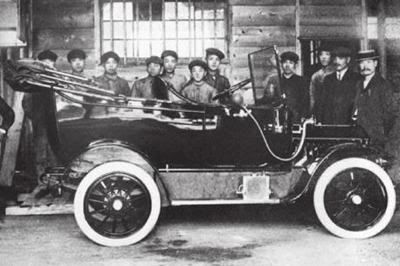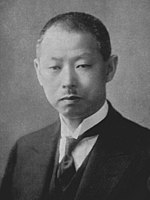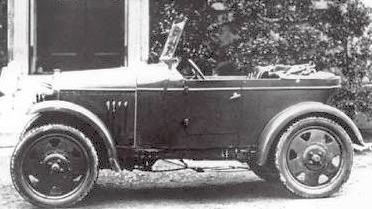The Datsun brand of cars came out of the merger of two early Japan car companies, DAT Automobile Co. and Jitsuyo Automobile Co. This new company DAT Automobile Manufacturing Co. eventually created the Datsun brand. Shortly after the first Datsun was produced in 1931, the fledgling Nippon Sangyo holding company, desiring to enter the automobile business, takes over DAT in 1933. The next year Nippon Sangyo names the car company Nissan Motors. The rest is history and today the company is known as Nissan Motor Co., Ltd (?????????).
Kwaishinsha
1911 July 1: Masujiro Hashimoto forms ???????? (Kwaishinsha Automobile Works) in Azabu district of Tokyo, with backers of Den, Aoyama and Takeuichi. The initials DAT are eventually applied to name the car project. ??????? literally means "advanced car factory".
1912: Hashimoto builds first prototype DAT automobile. In Japanese DAT (pronounced 'datto') is ??, which means 'bounding away' -- a derivation of the word for rabbit/hare -- so it is fitting for a young company's automobile hopes.
1913: Second car, the DAT 1, is created
1914 March: DAT 1 wins a Bronze Medal prize at Tokyo Taisho Expo
- V2 engine two-cylinder v-formation
- 10 HP, top speed 32kph
1914: ??????? (Kwaishinsha Automobile Works) is established in Tokyo. Apparently it is the first automobile manufacturer registered with the Japanese government.
1915: DAT 31 birth, with 2-liter 4-cylinder engine fitting
1916: DAT 41 birth, with bored 2.3-liter engine, 15 HP. Produced until 1926.
1918: Renamed to Kwaishinsha Automobile Co., Ltd. (???????)
Jitsuyo
1919: Kubota (the tractor company) forms a subsidiary to manufacture cars, named it ????? (Jitsuyo Automobiles) in Osaka. American William R. Gorham previously had approached Kubota with a design for a design for a two passenger three-wheeled car powered by Harley-Davidson motorcycle engine. Gonshiro Kuboto, company head, creates Jitsuyo with W.R. Gorham as Chief Engineer.
1920: Jitsuyo's first product is the small three-wheeled "Gorham" car. Production of Gorham 3-wheeler. About 150 Gorhams are sold.
1921 October 24: Gorham 1 car ended (3-wheeler)
1921 November: William R. Gorham and ???? (Takayoshi Goto) completes a four-wheel car design by converting the Gorham to four wheels, but then Gorham leaves Jitsuyo to work for Tobata Castings. About 100 of these cars are sold.
1921: Takayoshi Goto creates the Lila Light Car, based on a rework of Gorham's original design.
-

- Jitsuyo Lila
- production from 1922-1926, about 200 cars total production
- 10 HP, top speed 30 mph
- both car and truck models offered
- popular in Tokyo taxi market due to narrow 40-inch track
1923: 1st Lila completed
1924: Lila modified for worm gear by Goto
DAT Co.
1925: ???? ??? (Kwaishinsha Automobile Co.) is renamed to ???? ???????? (DAT Automobile Co.)
Merger of DAT and Jitsuyo
1926: DAT and Jitsuyo merge, to form ???????????? (DAT Automobile Manufacturing Co.,). Headquarters are in Osaka. Jitsuyo, in the face of intense competition from Ford and GM in Japan, was only selling about 150 cars per year. It barely survived by taking on work from Kubota and even GM. Therefore a merger with DAT was sought. DAT had military truck contracts, so was in better condition than Jitsuyo.
1928: DAT 91 planned (500cc class)
1929: DAT 91 experimental testing
1930 August: DAT 91 small car design (Datson) completed, with 500cc engine fitting. Production is intended.
Nippon Sangyo
1928: ????(Yoshisuke Aikawa) founds the holding company Nippon Sangyo (Japan/Nippon Industries). Aikawa's passion is mass-producting autos, and this fledging company soon begins buying or taking over other established companies.
- Yoshisuke Aikawa in 1939
Takeover of DAT
1931: Nippon Sangyo controls foundries and auto parts businesses, but no automobile manufacturing. Aikawa purchases controlling shares in DAT Motors
First Datsun
1931 August: DAT comes out with a new smaller car, the first Datson, meaning "Son of DAT". It is a two-passenger car.
1932 March: Datson mark is renamed Datsun, a more harmonious spelling. Reportedly though perhaps apocryphal, is that after the DAT factory was victimized by flooding during a typhoon, it was attributed to the "son" in Datson (son in Japanese means 'loss'). In any case, the spelling was changed to "sun". Interestingly it fits with the Japanese 'sun' flag logo shown on the 1931 Dotson catalog. Sun has no particular meaning in Japanese, except that it is pronounced 'san'. Nominally, san is a title of respect, roughly equivalent to the english Mr. or Mrs.
The Datsun mark, with red, white and blue sections, is created by ???? (Yoshizaki Ryouzou) and ????? (Tanaka Tsunesaburou). They are inspired by the Chevrolet mark. The white background red round portion represents Hinomaru (sun disc), Japan's white national Flag with red sun (morning rising sun). The cobalt blue section represent the sky.
 |  |  |
1932 April 15: Datsun ????? (Automobile Chamber of Commerce) established
Datsun Type 11
The first car to use the new spelling 'Datsun' is the 1932 Datsun Type 11.
- 1932 Prototype ???
- 1931-style wide metal spoke wheels
- 1931-style upswept rear body
- 1932-style bonnet louvers
- seat forward of rear wheel

- 1932 Datsun Type 12 Phaeton
- 1932 production: ~150
- Sedan weight: 400 kg, Overall length: 2710mm, Width: 1175mm, Tire Size: 24"x4", Wheelbase: 1880mm, Track: 965mm
- Made in Osaka
- Engine: 747cc, 56mm bore

![[Datsun 1200 encyclopedia]](/wiki/upload/wiki.png)





